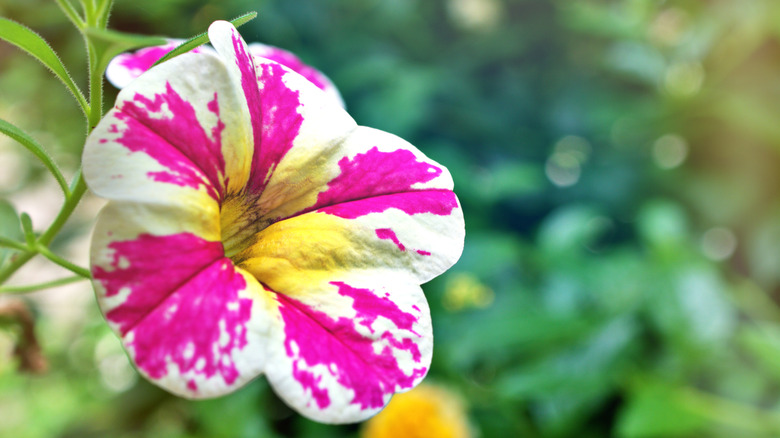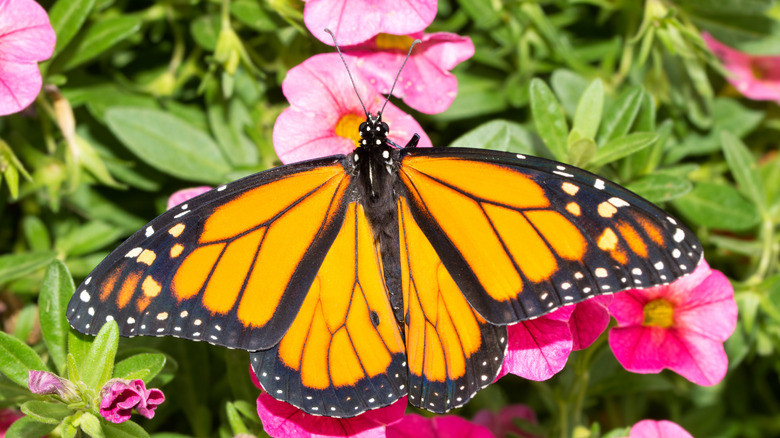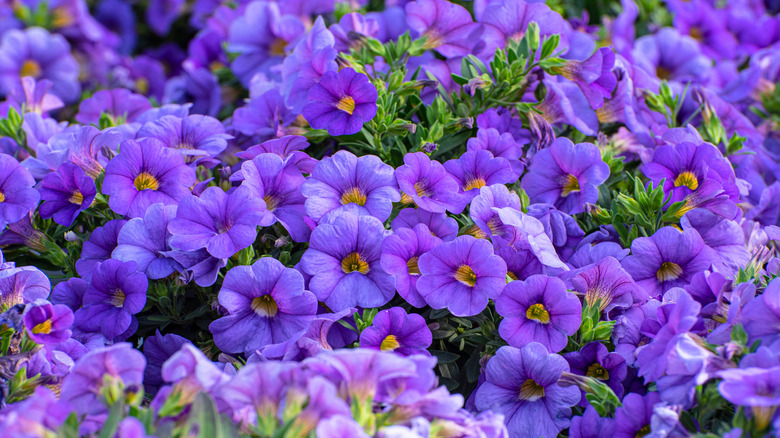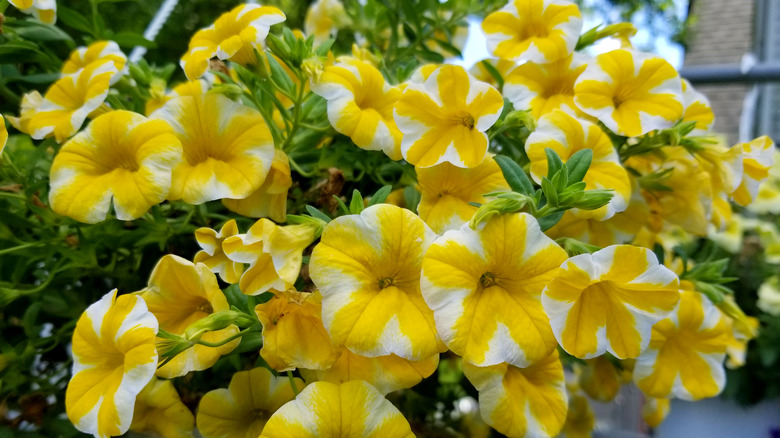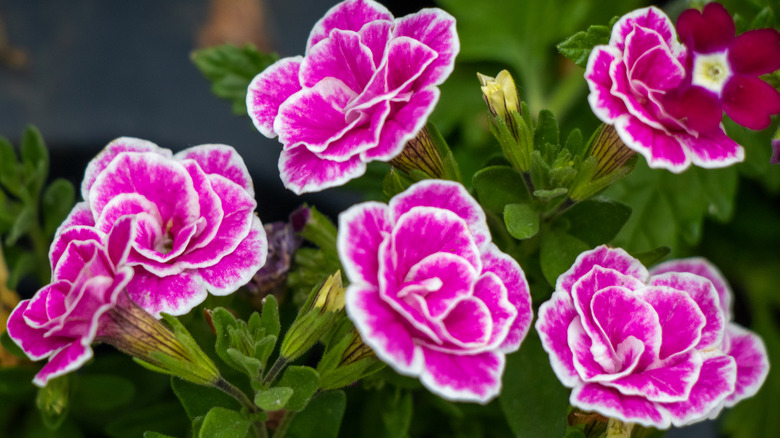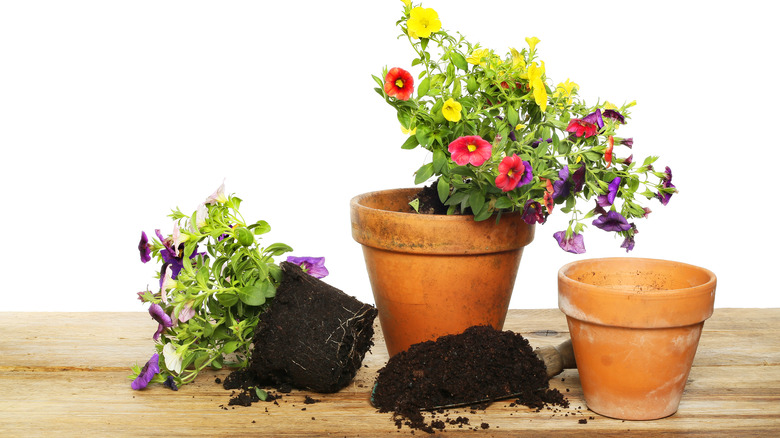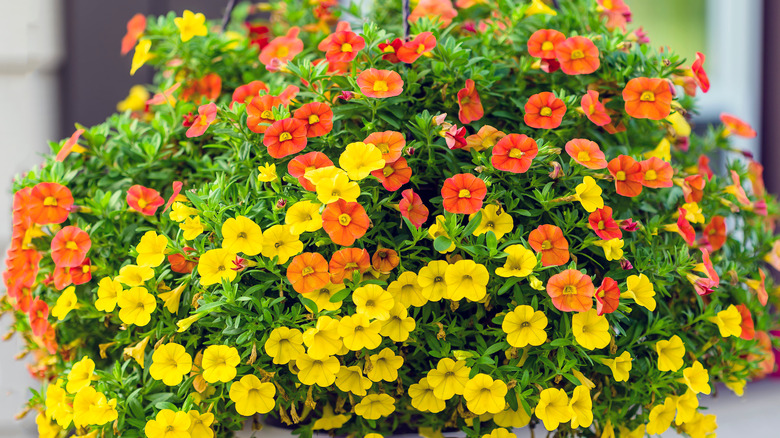How To Care For Million Bells Flowers
Million Bells® and Super Bells® are trademarked names for all hybrids of the bright and whimsical calibrachoa flowers original to South America. They were first cultivated in North America by the Suntory Flowers company in 1993. According to Perishable News, with this new product, the Suntory breeders showed the everyday novice horticulturist that it's possible to have both a beautiful garden and one that is easy to care for. Suntory is the same company that produces wine, whisky, and other beverages. At first, they only grew plants to use directly in their manufacturing recipes; however, biotech advancements convinced them to look into flower breeding as well. Since then, these flowers have adopted "million bells" as a common name and have been integrated into gardens and decoratively hung from porches and patios across the country.
All Calibrachoa plants (along with their Millions Bells® and Super Bells® counterparts) produce a sea of dazzling blooms from spring straight through to the first frost. They burst forth in an array of bright colors, including hot pinks, purples, corals, reds, and yellows. They also often have white mixed into their color palette. HGTV explains that, while these flowers look quite a bit like petunias, there is an ongoing debate regarding which genus they actually belong to. However, regardless of any scientific disagreements, all you need to do as a home gardener is enjoy the way they brighten any space!
How to use million bells flowers in the garden
Calibrachoa flowers grow as trailing vines, yet they do not get straggly. Instead, the plants remain flush and full. As a result, they make an excellent choice for a hanging basket since they will grow out, up, and down all at once. In fact, containers are where they are most often found. Each blossom will be close to 1 inch in diameter, and each plant can produce hundreds of blossoms. Window boxes, garden borders, hanging baskets lining porches and patios — there are many ways to decorate a home or landscape with these fast-growing crowd-pleasers.
One of the most important aspects of million bells flowers is their propensity for drawing butterflies, hummingbirds, and other beneficial pollinators to a garden. They are attracted to the colors, so planting them in large groups is recommended by The Spruce to make them the most visible to a passing eye mid-flight. Hummingbirds are partial to red flowers and require a water source in addition to the nectar provided by the plant. Mechanically operated waterfalls and fountains are options, but you could also simply hang a hummingbird feeder with water or pre-made nectar. Refrain from using pesticides once you've attracted these delightful creatures to your garden. You'll also need to take good care of the inevitable caterpillars as they arrive and be prepared to accept some leaf nibbling.
How to grow million bells flowers
Millions bells flowers originated in a warm climate and will live year-round when planted in temperature zones 9 and higher. If you live somewhere cooler, you'll need to treat them as summer annuals and replenish your gardens and patios with new plants each spring. They do best in containers with full sun and the best drainage possible. However, they can handle a small amount of shade and be planted in the ground once the temperature stays above 55°F. Adding mulch will help keep the soil aerated and give the roots time to dry before the next watering.
Growing new calibrachoas from seed is unlikely to work because they produce very few seeds. In these cases, commercial garden centers use a process called vegetative propagation. Because these hybrids are trademarked, propagation is restricted in a commercial setting. That said, you can easily grow new plants from cuttings of the ones you purchase at the store. Gardening Know How lays out a simple method that begins with moving your calibrachoa indoors for the winter. Come springtime, fill a small grow pot with half potting soil and half peat moss mixed well. Locate a healthy stem with small buds that have not yet opened or flowered, and make a clean cut 6 inches down or more. Root your stem into the growing medium with the cut end down. Water and keep warm until roots develop and new growth appears above the soil.
How to care for million bells flowers
Millions bells flowers need to be properly hydrated, but they do not perform well in damp soil. These plants are sun worshipers and require not just well-draining soil but fast-draining. Plant care enthusiasts at Plant Addicts recommend a pH range of 5 to 6.5 in the potting soil.
Another popular characteristic of millions bells is that they are considered self-cleaning. This means dead flowers fall off without manual assistance. To keep your plant in full bloom, fertilize every two to three weeks. Yellowing leaves can be a sign of two contradictory issues: First, your plant may simply need more fertilizer or sun if it's in a shady spot. Second, it may have received too much fertilizer, and the pH level is off. Consult your local garden center if you are fertilizing regularly but still see yellow leaves. An iron chelate treatment may do the trick. Brown leaves are likely to be caused by inconsistent watering. When winter is on its way, and cold weather hits, bring any plants you wish to keep alive indoors. Cease using fertilizer and cut back on watering until it's warm again.
Million bells varieties
With over 28 species, it can feel like an onslaught of options when picking out the best calibrachoa for your home or garden. The good news here is that all of them perform in the same way under the same conditions. It's really only flower color that is a substantial difference between the many varieties of calibrachoas. A double or single flower in regards to the number of petals can also come into play. But for the most part, it's all about your preferred color palette. Here are some million bells varieties, as noted by Proven Winners.
- Doublette Love Swept is an award-winning hybrid from Proven Winners. Each petal of this double flower has a stark white outline surrounding a vivid and lively pink hue.
- Lemon Slice combines a bright yellow star form with white highlights in a pinwheel pattern of alternating hues.
- Grape Punch presents in a lovely deep purple hue. Its flower size is larger for a Calibrabhoa as it can get to 1 1/2 inches.
- Cherry Star offers a reddish-pink-toned flower with yellow centers and veins and does well in the heat.
- Holy Moly calibrachoas have a colorful palette that mixes light yellow and red, reminiscent of peppermint candy.
- Holy Smokes has a nice mix of violet splashes over a yellow and white background.
- Coral Sun variety offers tangerine petals bursting with yellow centers, creating one of the brightest and most pleasant color combinations.
Are million bells flowers toxic?
Calibrachoas are generally considered nontoxic plants for both humans and pets. However, it's still important to note that, botanically speaking, they belong to the Solanaceae family, also known as nightshades, which can be deadly. The Solanaceae family is a tricky one to grasp because it produces some of the most commonly eaten vegetables in the world, from peppers to tomatoes and potatoes, as well as the deadly nightshade flower, all parts of which are lethal when swallowed.
The US Forest Service describes the psychoactive alkaloids contained in plants of the nightshade family as a chemical mix of fascinating and toxic compounds, collectively called tropane alkaloids. Simply put, they have the potential to heal in small doses or seriously harm in larger doses. Solanine is the alkaloid most often in question regarding toxicity in pets and their human companions. Although they are members of the nightshade family, calibrachoas specifically have not been shown to contain solanine. Use caution anytime you're unsure. An easy solution is to keep your million bells in their hanging baskets and let them adorn window ledges safely out of reach of your pets' curious noses. And, of course, reach out to your veterinarian in the case of ingestion.
How to repot your million bells flowers
Spring is the time of year to get your potting supplies spiffed up and ready to go when it comes to million bells flowers. Per the Suntory Collection, a YouTube channel by the original propagators of Million Bells® plants, it's best to choose a larger pot to move your plant into. Either a paper pot designed for best drainage or a clay pot with added broken clay or stones on the bottom to assist with drainage will do. Hanging baskets work beautifully as well and should already have plenty of holes in them. When you have an appropriate container, fill it with potting compost made from peat and perlite to facilitate even faster drainage.
Brace the base of the plant with your fingers spread out along the top of the soil. Flip the plant over, tap on the bottom of the pot to release it into your hand, and take a quick peek to confirm healthy white roots. With one hand holding your plant, use the other to pull out soil from the center of the pot, creating a hole into which you can now place your plant securely. Replace as much of the extracted soil as possible, press down gently, and water thoroughly with a spraying hose. For this first watering only, allow the water to drain and repeat the process one more time. As your plant settles in and continues to grow, its water and food (fertilizer) needs may increase.
Black root rot in million bells flowers
Onfloriculture, a blog maintained by greenhouse floriculture specialists from the Ministry of Agriculture, Food and Rural Affairs (OMAFRA), cites a 2017 study on Black Root Rot and its specific ties to the calibrachoa. Using DNA evidence to zero in on the most harmful and prevalent diseases suffered by these plants, they concluded that yellowed leaves are the most common indicator that root rot has occurred. Untreated, this problem will undoubtedly kill a plant. But there is hope for sufficient treatment via the systemic fungicide thiophanate-methyl that goes by the brand name of Senator 70 WP.
Any gardener can take a few preventative measures to make sure their plants are set up for success before even bringing them home. First and most important, you should control fungus gnats and shore flies using appropriate soil conditioners such as nematodes and predatory mites. Second, monitor the pH level of your soil and lower it when necessary by mixing in coffee grounds, sphagnum peat, or other organic materials. Lastly, apply a bio-fungicide that contains Trichoderma harzianum when initially planting.
